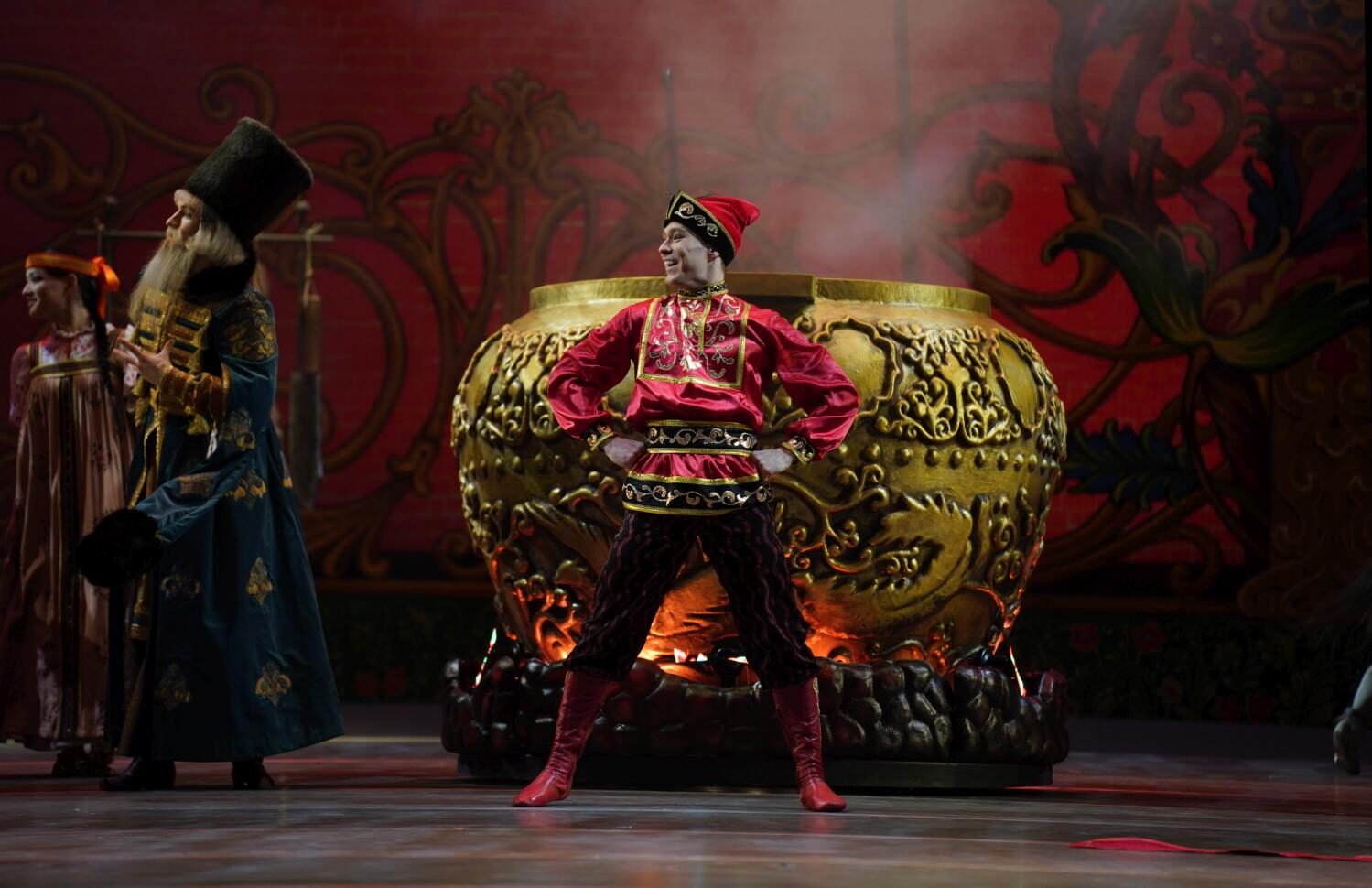“Stravinsky in Paris” (“Farewell in Paris”/“Le Sacre du Printemps”)
State Ballet of the Gärtnerplatztheater, Munich
Forum Ludwigsburg
Ludwigsburg, Germany
July 30, 2025
by Ilona Landgraf
Copyright © 2025 by Ilona Landgraf
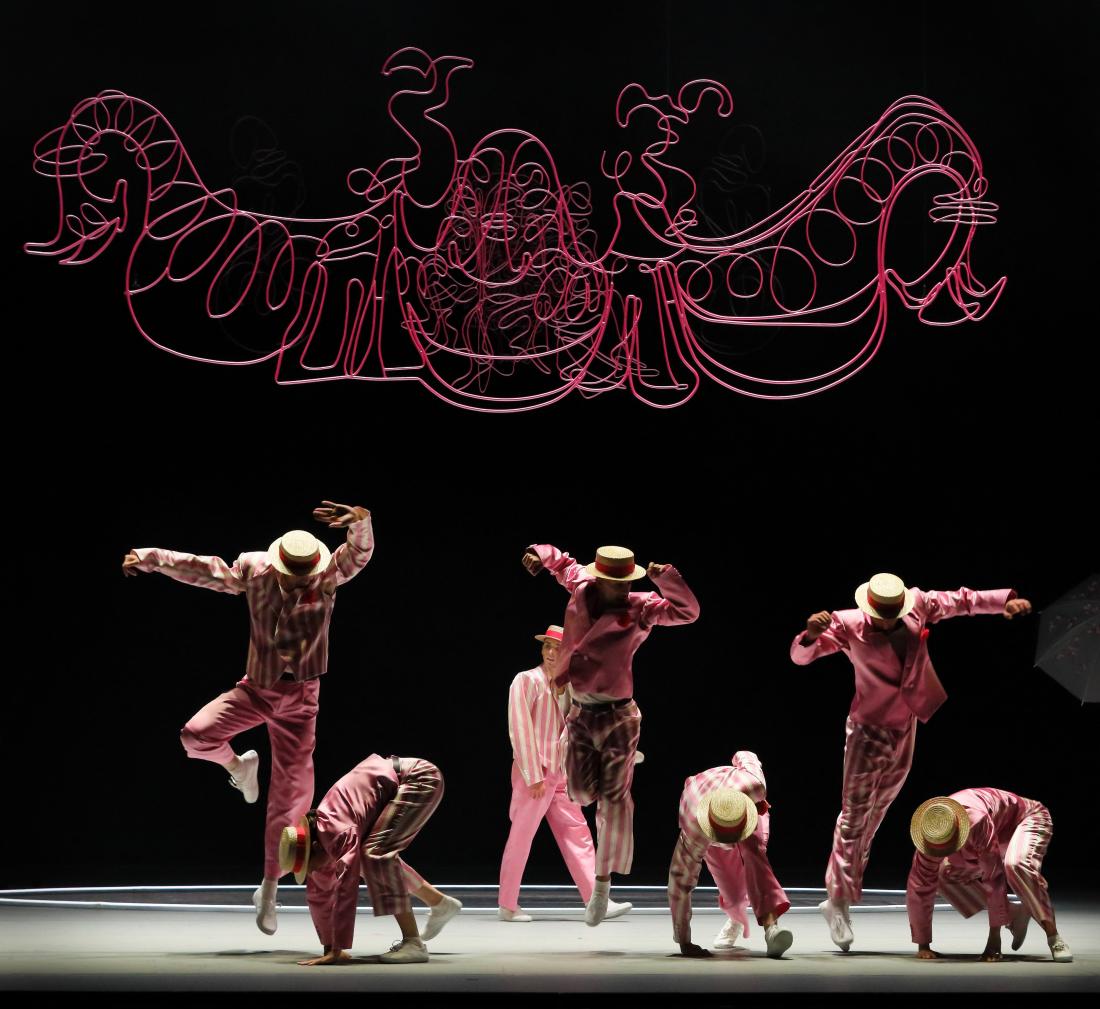 Since 1932, the city of Ludwigsburg in Baden-Württemberg has hosted an annual summer festival featuring various cultural genres. Many events are held at the Ludwigsburg Palace, a vast complex that served as the Duke of Württemberg’s residence after its completion in 1733. Munich’s State Ballet of the Gärtnerplatztheater, whose Stravinsky in Paris marked the festival’s final dance event, performed at the Ludwigsburg Forum near the palace. Last October, the Gärtnerplatztheater showed Troja (“Troy”) by the Greek-born Andonis Foniadakis on its tour to Ludwigsburg. Its display of sexist abuse was annoying. As the press praised Stravinsky in Paris as a “confetti rocket,” I was curious about its “sophisticated dance and music.”
Since 1932, the city of Ludwigsburg in Baden-Württemberg has hosted an annual summer festival featuring various cultural genres. Many events are held at the Ludwigsburg Palace, a vast complex that served as the Duke of Württemberg’s residence after its completion in 1733. Munich’s State Ballet of the Gärtnerplatztheater, whose Stravinsky in Paris marked the festival’s final dance event, performed at the Ludwigsburg Forum near the palace. Last October, the Gärtnerplatztheater showed Troja (“Troy”) by the Greek-born Andonis Foniadakis on its tour to Ludwigsburg. Its display of sexist abuse was annoying. As the press praised Stravinsky in Paris as a “confetti rocket,” I was curious about its “sophisticated dance and music.”
Stravinsky in Paris, a co-production of the Gärtenerplatztheater and the Ludwigsburg Festival, recently premiered in Munich. The double bill combines Jeroen Verbruggen’s Farewell in Paris and Marco Goecke’s Le Sacre du Printemps.
The nonchalant steps of the straw-hatted men who opened Farewell to Paris seemed inspired by a blend of Broadway style and Parisian savoir vivre. In their pale pink of their blazers and pants, they seemed to belong in a little girl’s dream (costumes by Emmanuel Maria).
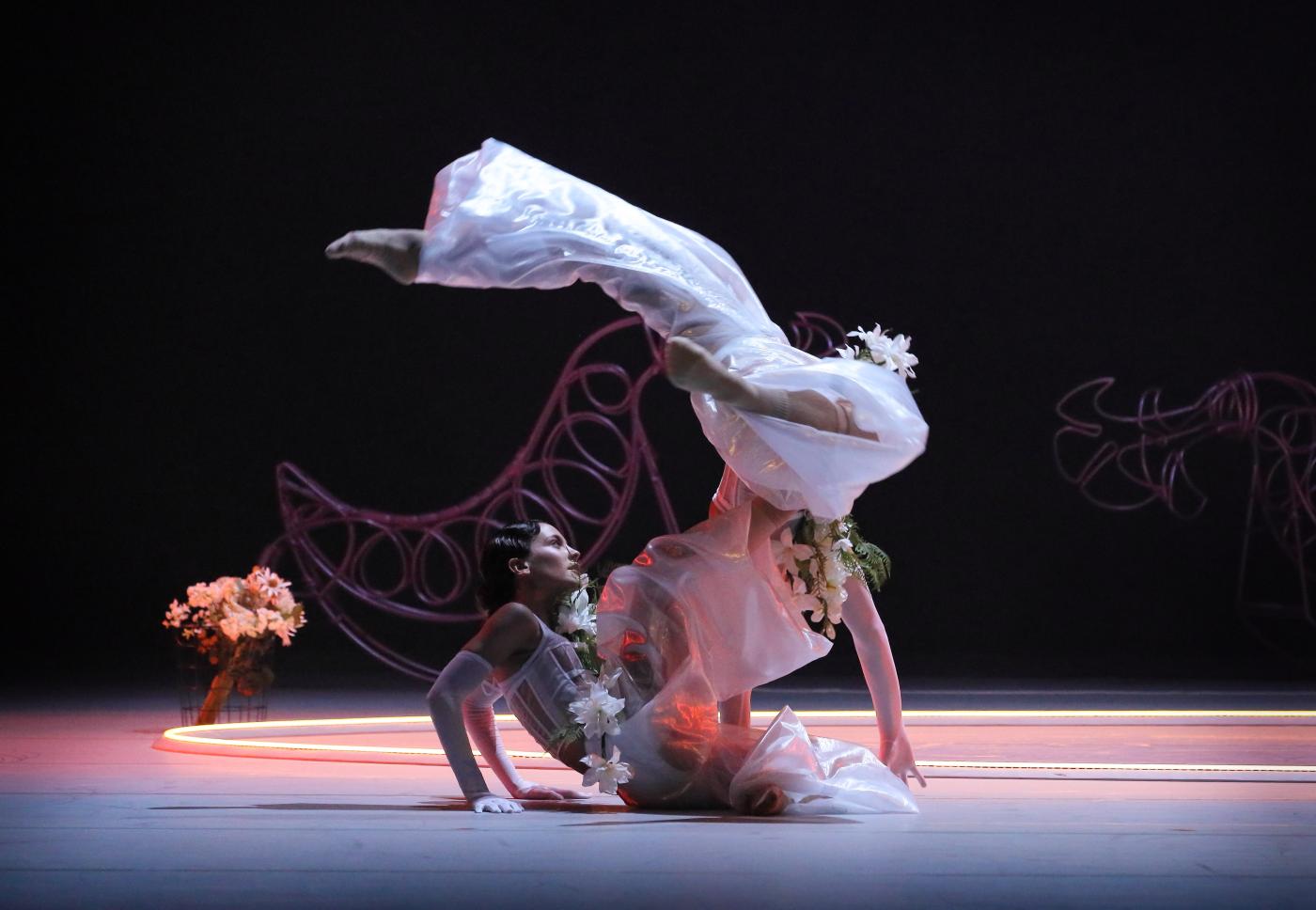
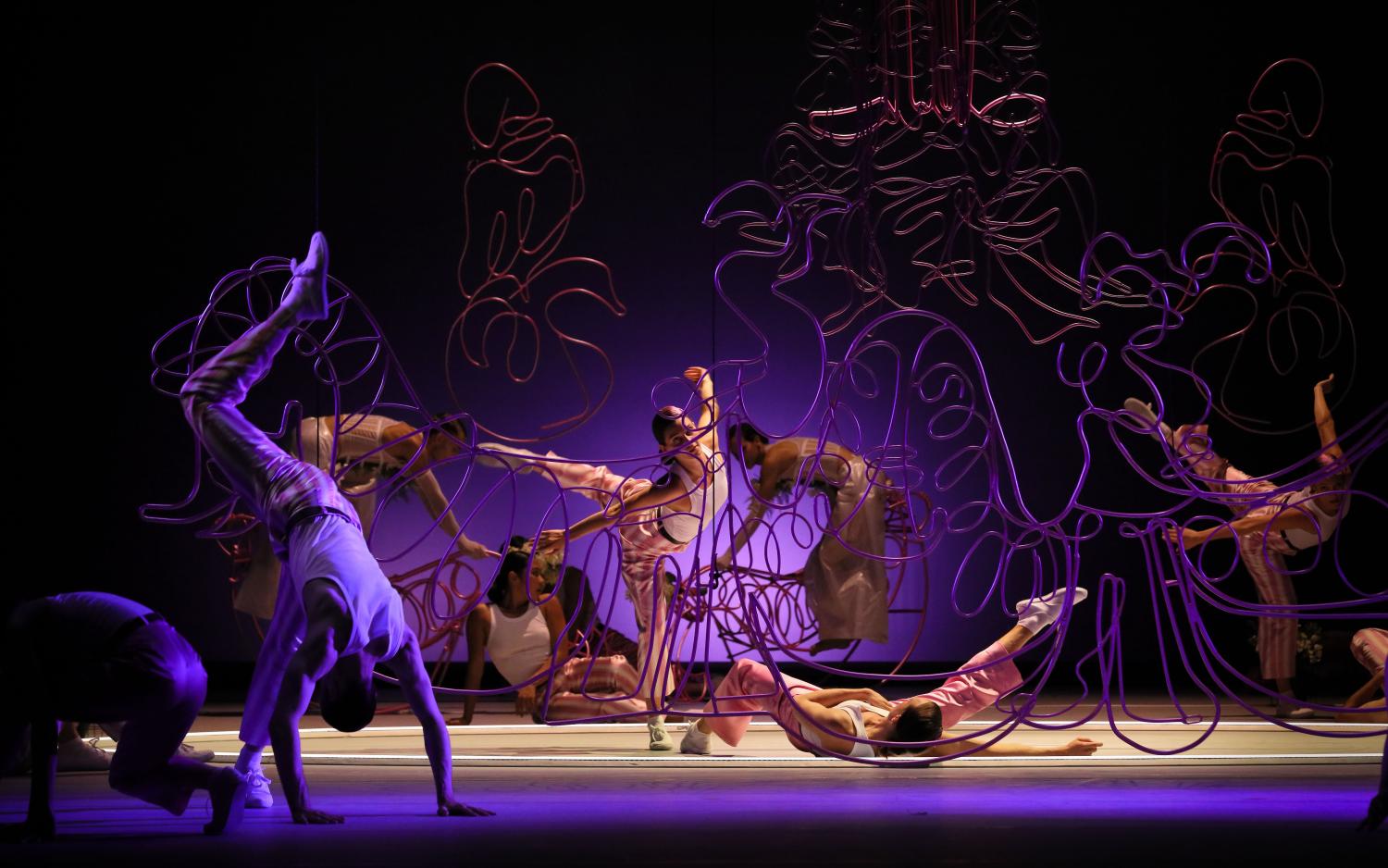 Carried by the jazzy vibes of Gershwin’s An American in Paris, they dropped to the ground, did somersaults and, when lifted, flailed their legs. Right away, Gershwin’s iconic music reminded me of Christopher Wheeldon’s ravishing musical, An American in Paris, at the Dominion Theatre in 2017 London. It was inspired by Vincente Minnelli’s eponymous 1951 film starring Gene Kelly as the World War II veteran, Jerry Mulligan, and Leslie Caron as Lise Bouvier, the young woman whom Jerry falls in love with.
Carried by the jazzy vibes of Gershwin’s An American in Paris, they dropped to the ground, did somersaults and, when lifted, flailed their legs. Right away, Gershwin’s iconic music reminded me of Christopher Wheeldon’s ravishing musical, An American in Paris, at the Dominion Theatre in 2017 London. It was inspired by Vincente Minnelli’s eponymous 1951 film starring Gene Kelly as the World War II veteran, Jerry Mulligan, and Leslie Caron as Lise Bouvier, the young woman whom Jerry falls in love with.
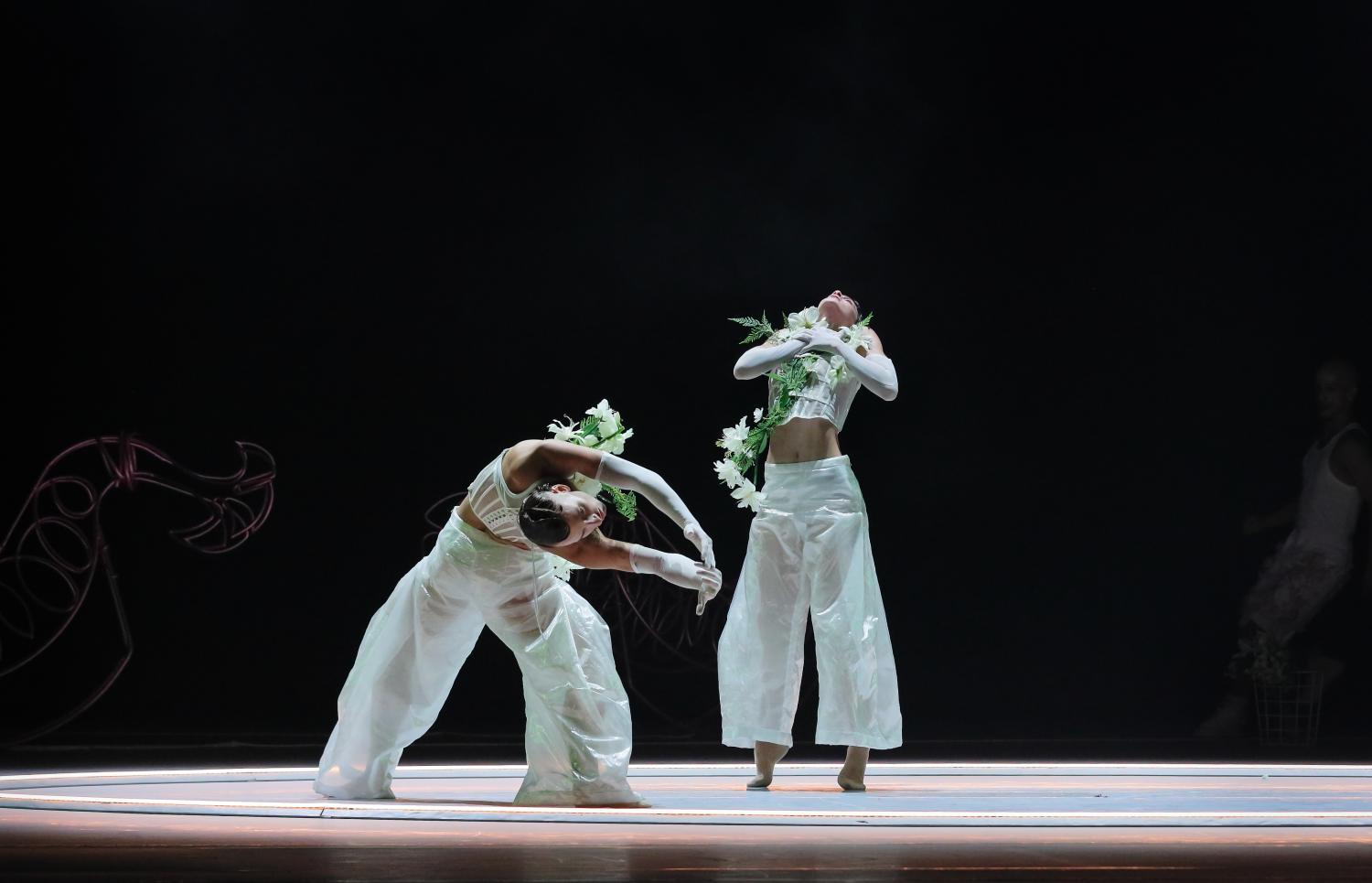
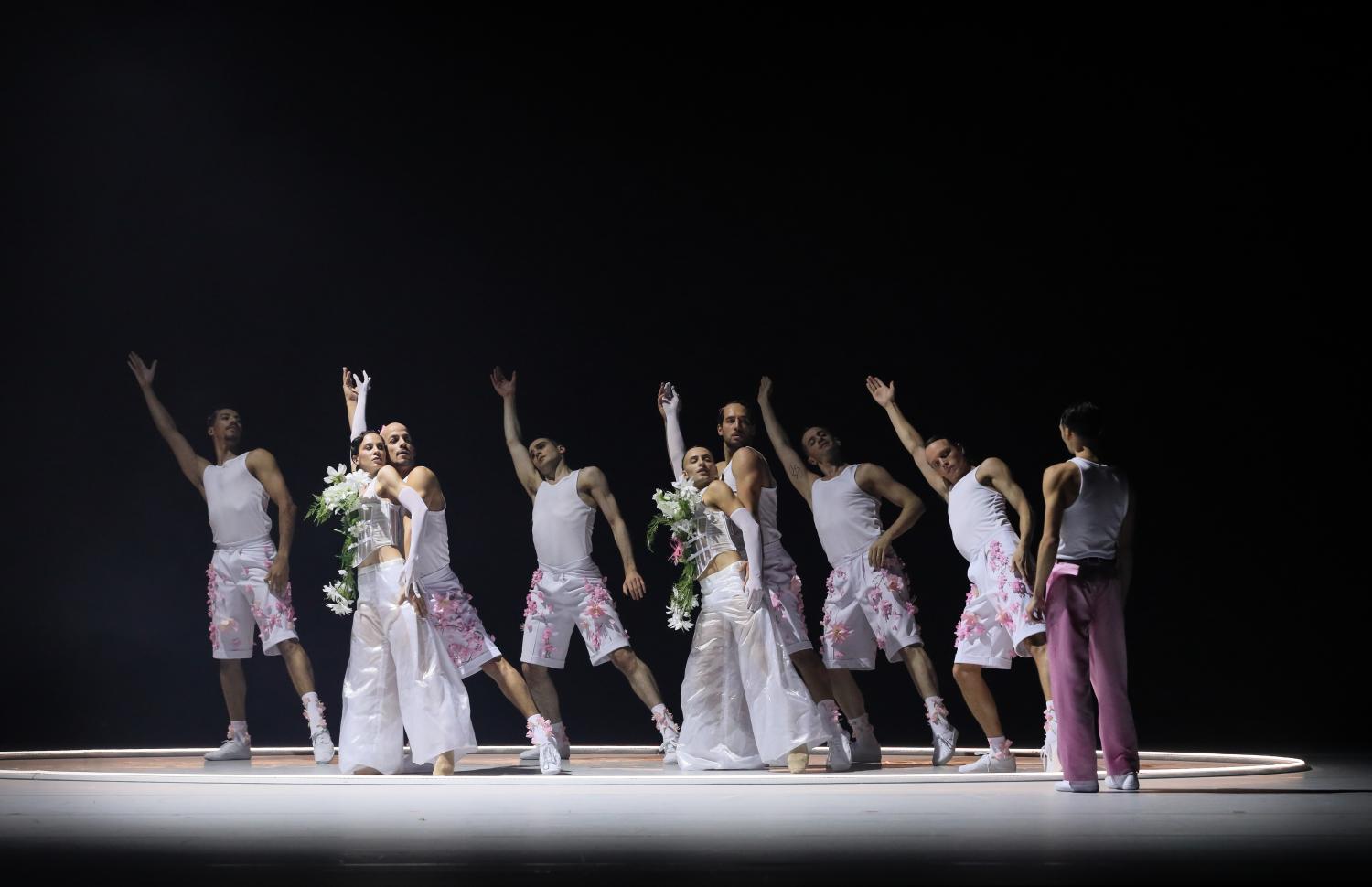 On Ludwigsburg’s stage, no romance blossomed, and no reasonable plot was evident. Instead, bunches of white flowers sporadically fell from the flies, and the dancers huddled under or wheeled two cream-white umbrellas. Jerry (Matthew Jared Perko) casually watched them from the sidelines and occasionally joined them.
On Ludwigsburg’s stage, no romance blossomed, and no reasonable plot was evident. Instead, bunches of white flowers sporadically fell from the flies, and the dancers huddled under or wheeled two cream-white umbrellas. Jerry (Matthew Jared Perko) casually watched them from the sidelines and occasionally joined them.
At center stage, a yellow LED circle symbolized the Place de la Concorde fountain of the final scene of Minnelli’s film. With plenty of imagination, the ornate, pink metal construct hanging above it represented its lower water fountain (set design by Natalia Kitamikado).
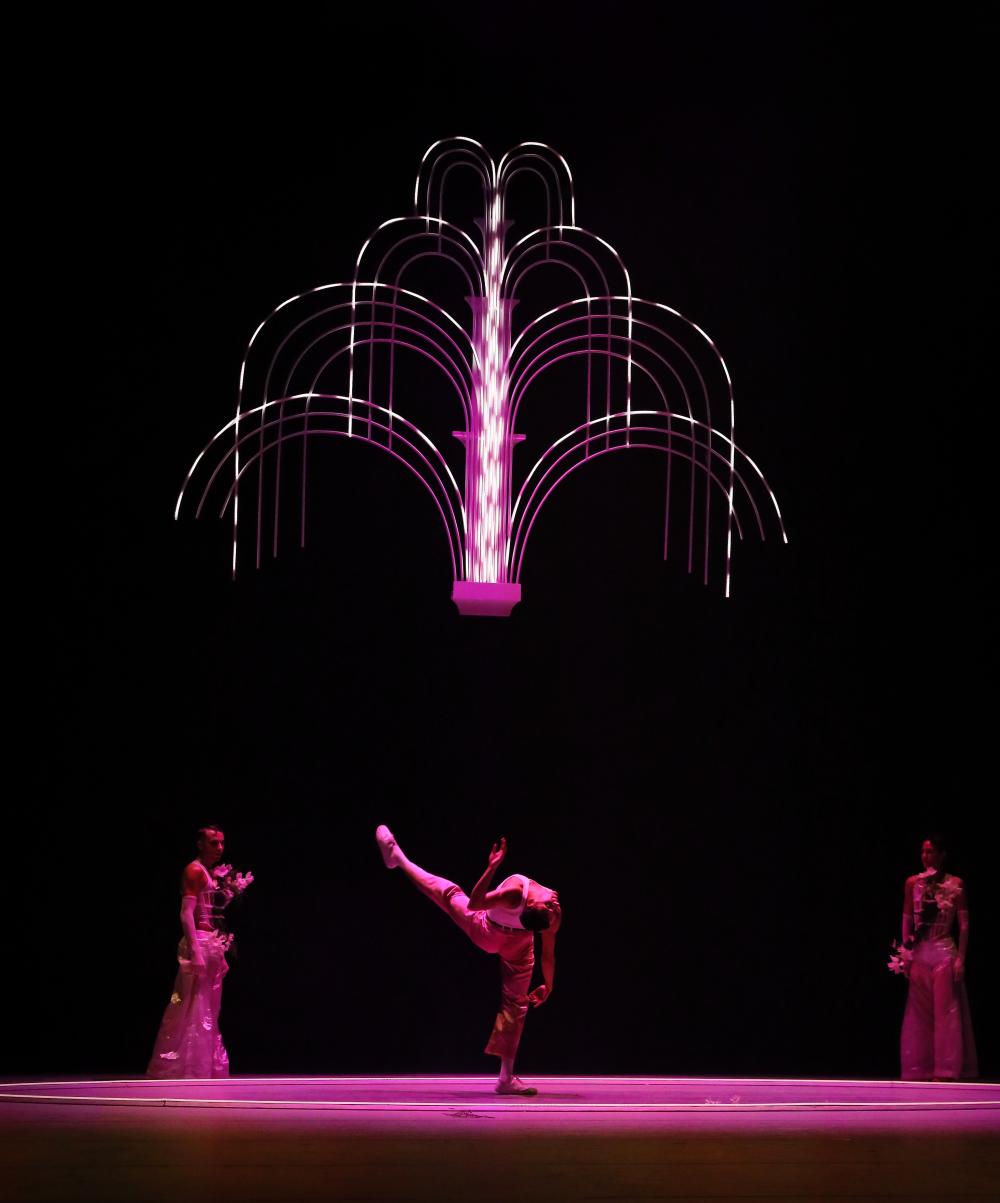
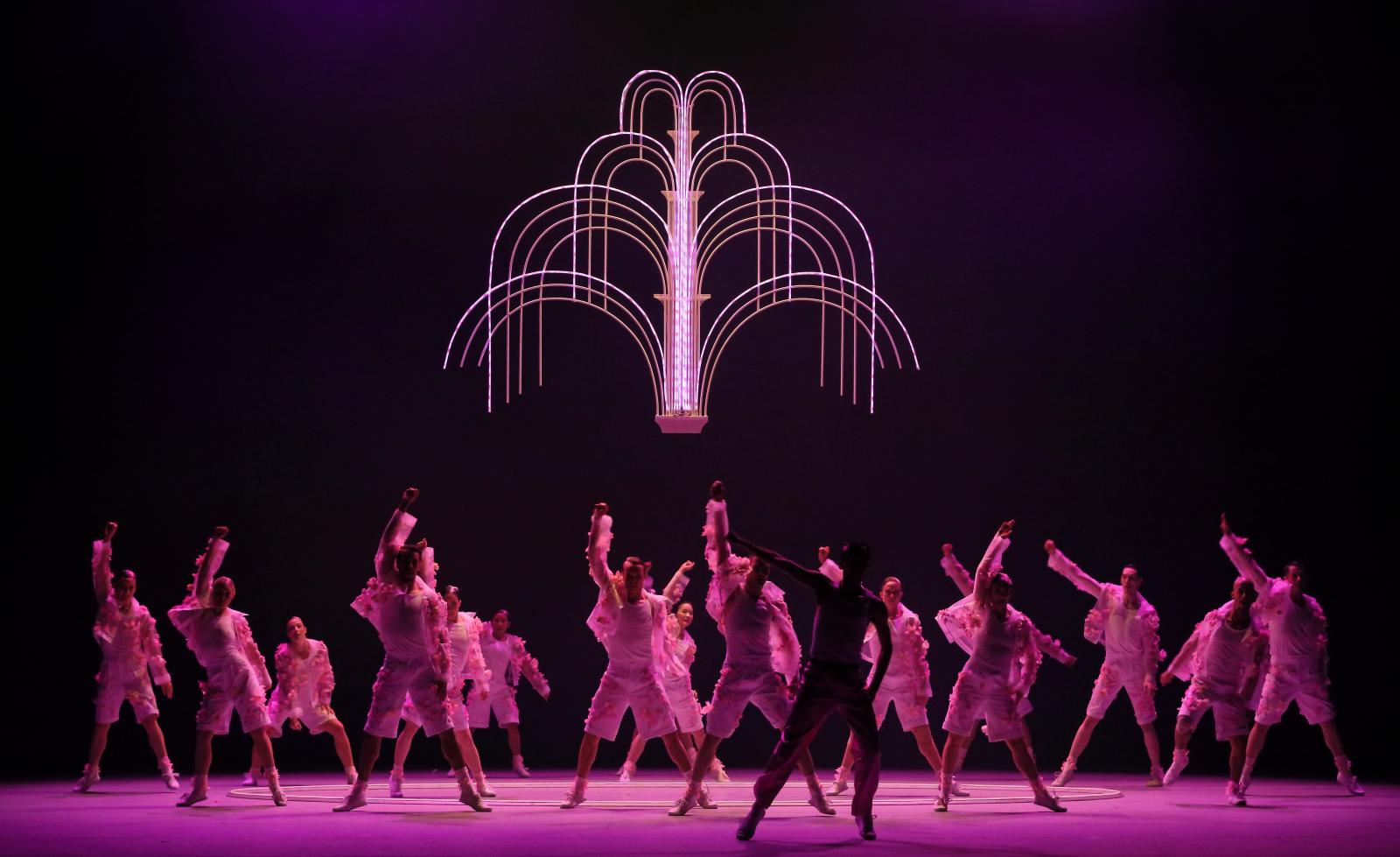 Against a kitschy purple backdrop, the dancers strutted at random and strolled hand in hand around the LED circle. A sudden gust blew some straw hats off, then the pink metal construct was slowly lowered, enclosing some strollers. On its backside, Micaela Romano Serrano and Ethan Ribeiro, both portraying anima (an animus was missing), rocked on carousel horse-like sculptures and laughed for no reason. They both wore transparent, wide white pants, white long-sleeved gloves, and white corsages decorated opulently with white flowers at the front and so were almost indistinguishable.
Against a kitschy purple backdrop, the dancers strutted at random and strolled hand in hand around the LED circle. A sudden gust blew some straw hats off, then the pink metal construct was slowly lowered, enclosing some strollers. On its backside, Micaela Romano Serrano and Ethan Ribeiro, both portraying anima (an animus was missing), rocked on carousel horse-like sculptures and laughed for no reason. They both wore transparent, wide white pants, white long-sleeved gloves, and white corsages decorated opulently with white flowers at the front and so were almost indistinguishable.
After dismounting from their horses, they fell on their backs like beetles, did reverse bridges, and slumped as if magnetically attracted to the ground. They rolled across the floor, performed acrobatics, and seemed to tangle into a knot with a man—presumably Jerry. Frosty silence made all the dancers crawl and roll across the floor and, one man (Jerry?), hiss like an angry dragon. Verbruggen interlaced Gershwin’s rhapsody with excerpts of Aaron Copland’s Billy the Kid suite, which engendered changes in mood and pace.
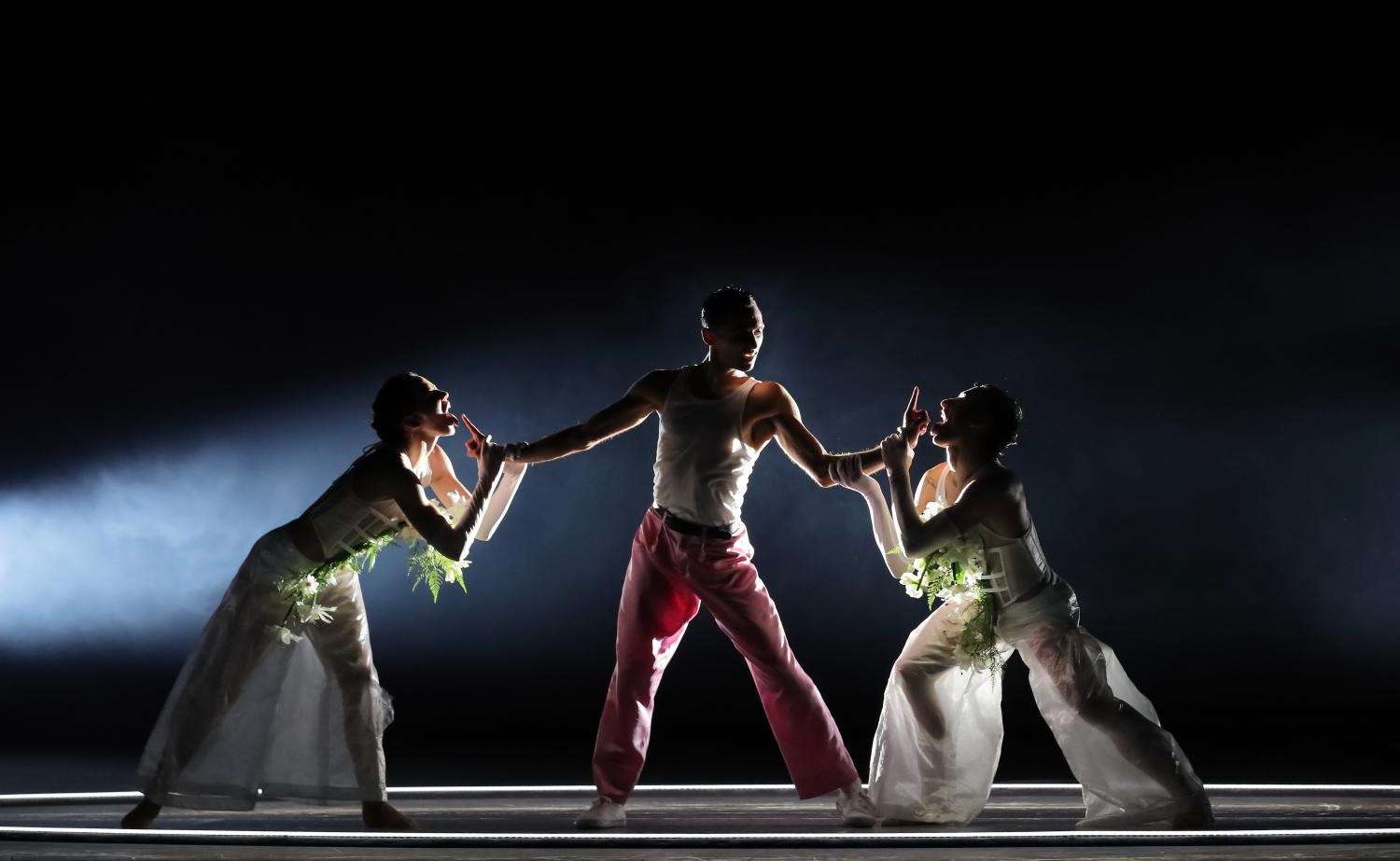
 Gershwin’s pulse infused the next scene’s swinging hips and protruding bottoms with sex appeal. Again, a fountain-like construct hung above the dancers, this time representing the central Place de la Concorde fountain. Its waterspout changed its color like a revue light organ. Meanwhile, the dancers screamed inaudibly, their arms plowing through the air, and changed into white jackets and white shorts with plenty of pink flowers. As if tiptoeing through a nightly revue, feet gently stepped forward and backward. For whatever reason, the umbrellas returned briefly, confetti rained down, and Jerry, suddenly struck by inspiration, held bunches of flowers in his hands. As he ran toward the backdrop, a flashlight lit in the darkness.
Gershwin’s pulse infused the next scene’s swinging hips and protruding bottoms with sex appeal. Again, a fountain-like construct hung above the dancers, this time representing the central Place de la Concorde fountain. Its waterspout changed its color like a revue light organ. Meanwhile, the dancers screamed inaudibly, their arms plowing through the air, and changed into white jackets and white shorts with plenty of pink flowers. As if tiptoeing through a nightly revue, feet gently stepped forward and backward. For whatever reason, the umbrellas returned briefly, confetti rained down, and Jerry, suddenly struck by inspiration, held bunches of flowers in his hands. As he ran toward the backdrop, a flashlight lit in the darkness.
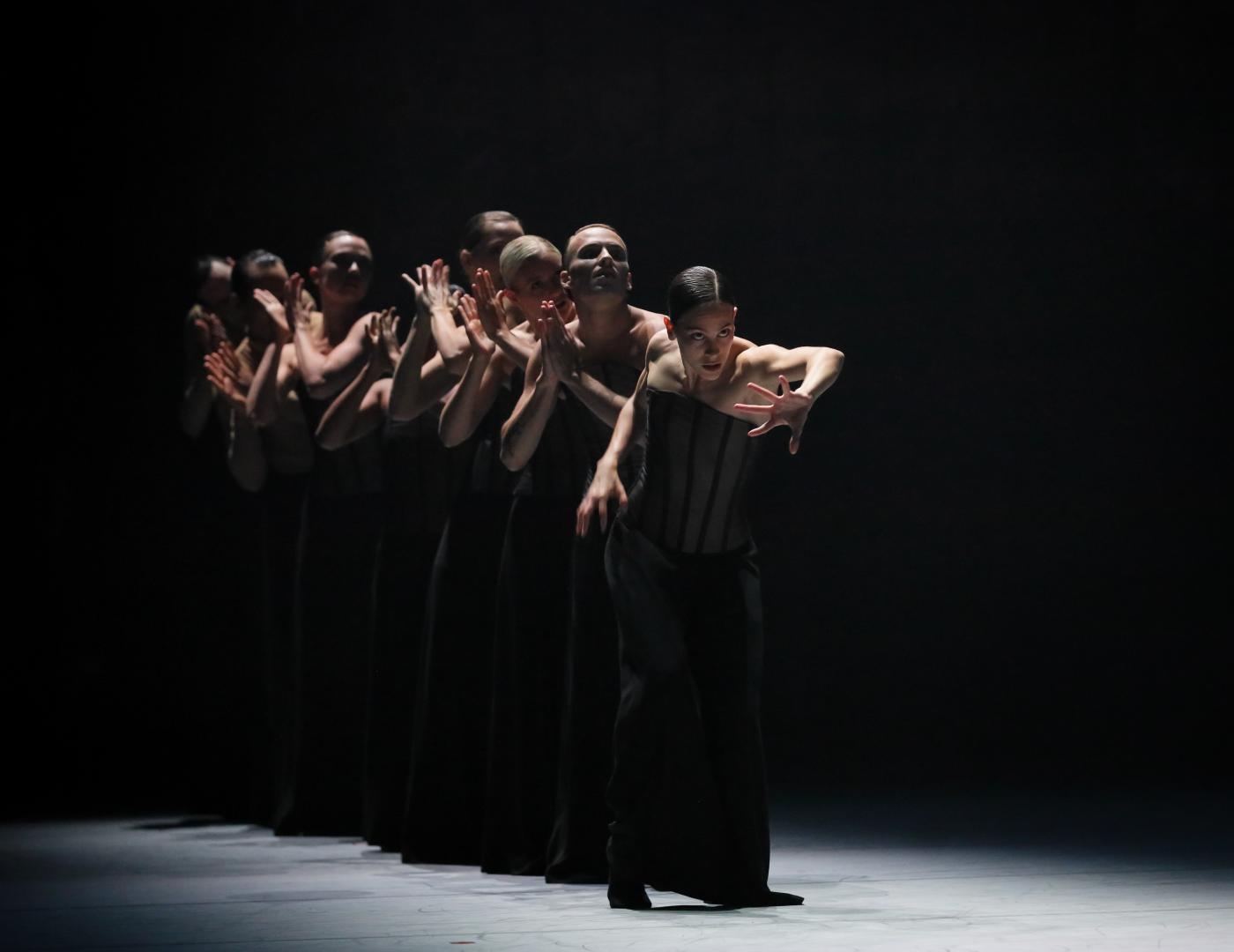
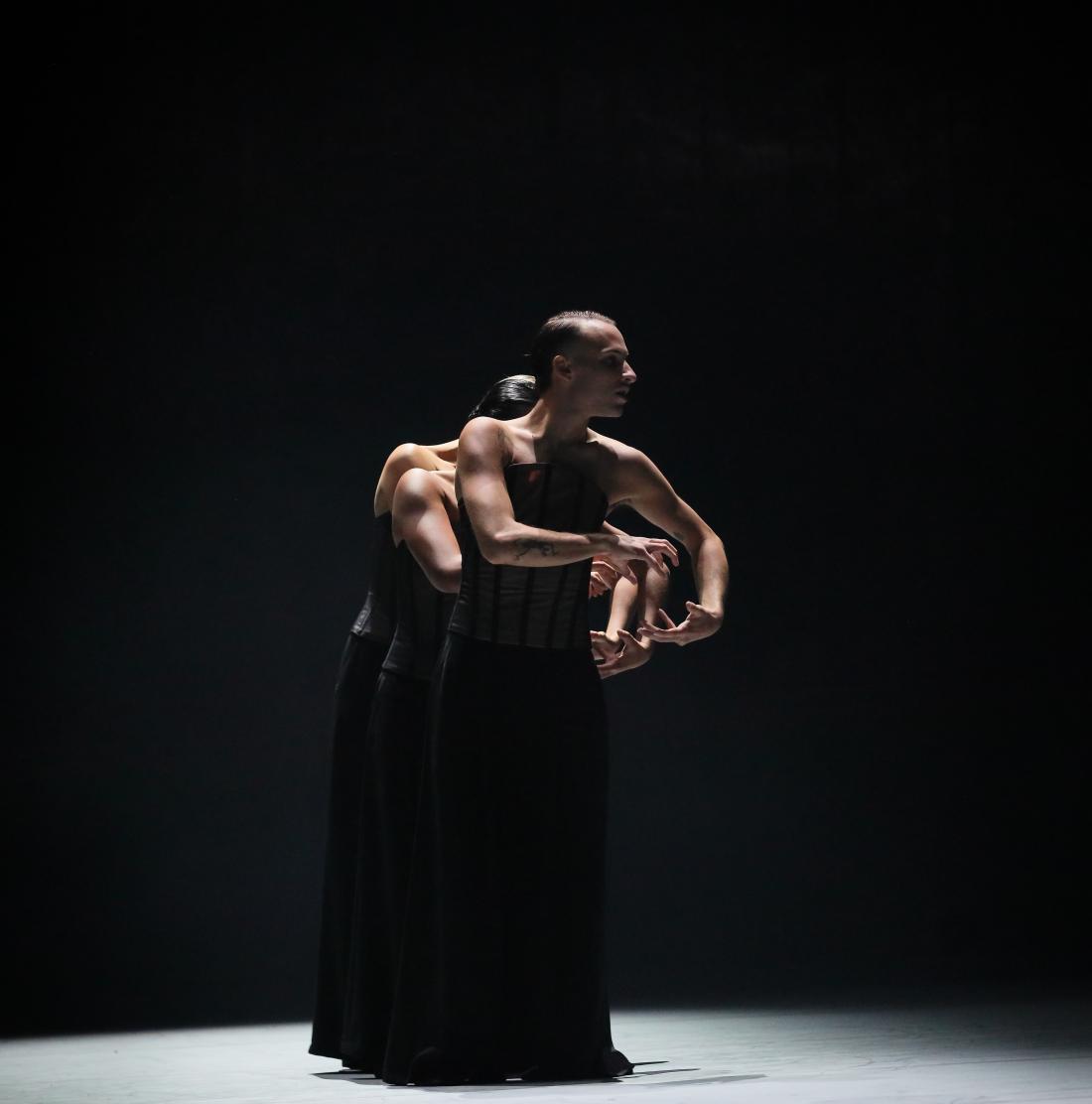 After a first half devoid of wit and meaning, the audience’s expectations rested on Goecke. Given his long career in nearby Stuttgart, local dance enthusiasts still consider him “ours.” They seemed glad about his return.
After a first half devoid of wit and meaning, the audience’s expectations rested on Goecke. Given his long career in nearby Stuttgart, local dance enthusiasts still consider him “ours.” They seemed glad about his return.
Goecke-typical darkness surrounded the man who wavered between uncertainty and decisiveness until the bassoon melody of Stravinsky’s Le Sacre du Printemps heralded what his steps seemed to seek. The man’s hands folded resolutely. But, shaking his head in denial, his knees yielded. Some curved, brown-black stripes on the backdrop that were reminiscent of trunks and branches became visible but then quickly faded.
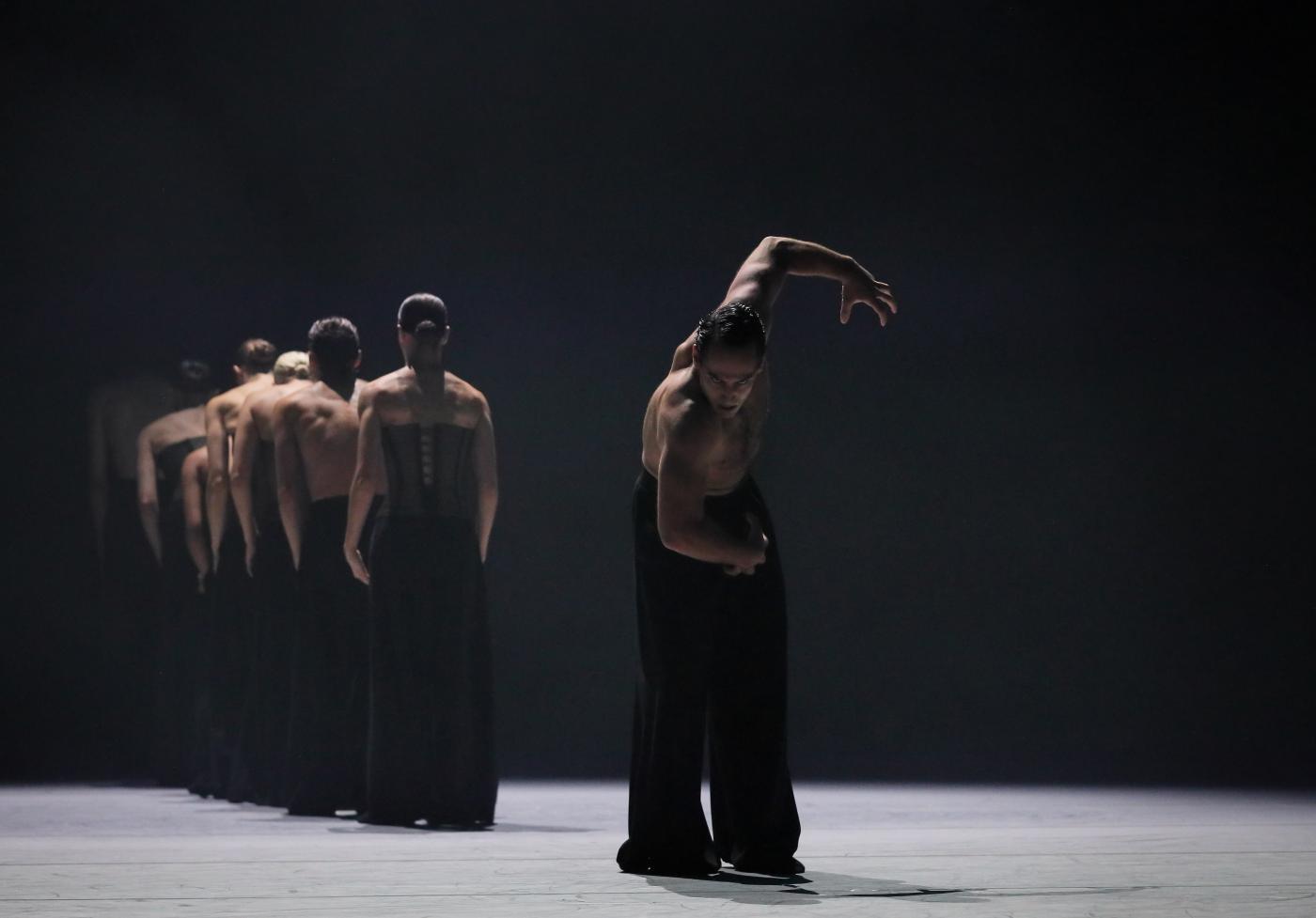
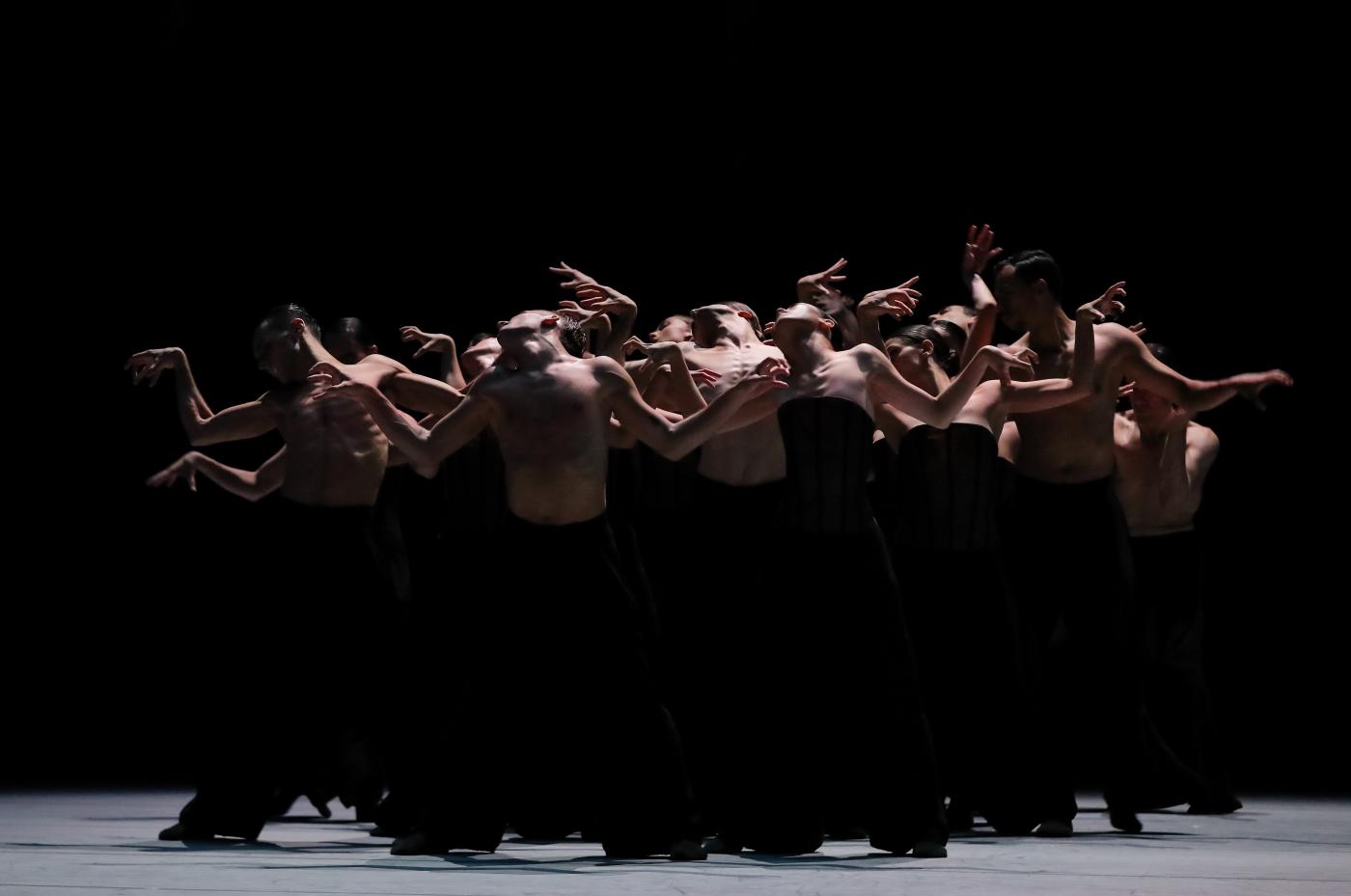 By then, the man’s limbs had taken on a life of their own. His shoulder snapped toward the belly again and again as if fastened to an elastic band, regardless of how often he stretched it open. His lower arms fluttered autonomously, and his legs hopped like rubber balls. He only gained control after clapping his hands. With feet flitting more quickly than my eyes could follow, he positioned himself at the top of a line that steadily grew with dancers. Their arms shivered and darted sideways with fingers cramped into claws, their legs flipped open and closed, and their mouths spoke agitatedly but voicelessly. The dancers seemed experts in Goecke’s high-voltage, ultra-precise, and lightning-fast style.
By then, the man’s limbs had taken on a life of their own. His shoulder snapped toward the belly again and again as if fastened to an elastic band, regardless of how often he stretched it open. His lower arms fluttered autonomously, and his legs hopped like rubber balls. He only gained control after clapping his hands. With feet flitting more quickly than my eyes could follow, he positioned himself at the top of a line that steadily grew with dancers. Their arms shivered and darted sideways with fingers cramped into claws, their legs flipped open and closed, and their mouths spoke agitatedly but voicelessly. The dancers seemed experts in Goecke’s high-voltage, ultra-precise, and lightning-fast style.
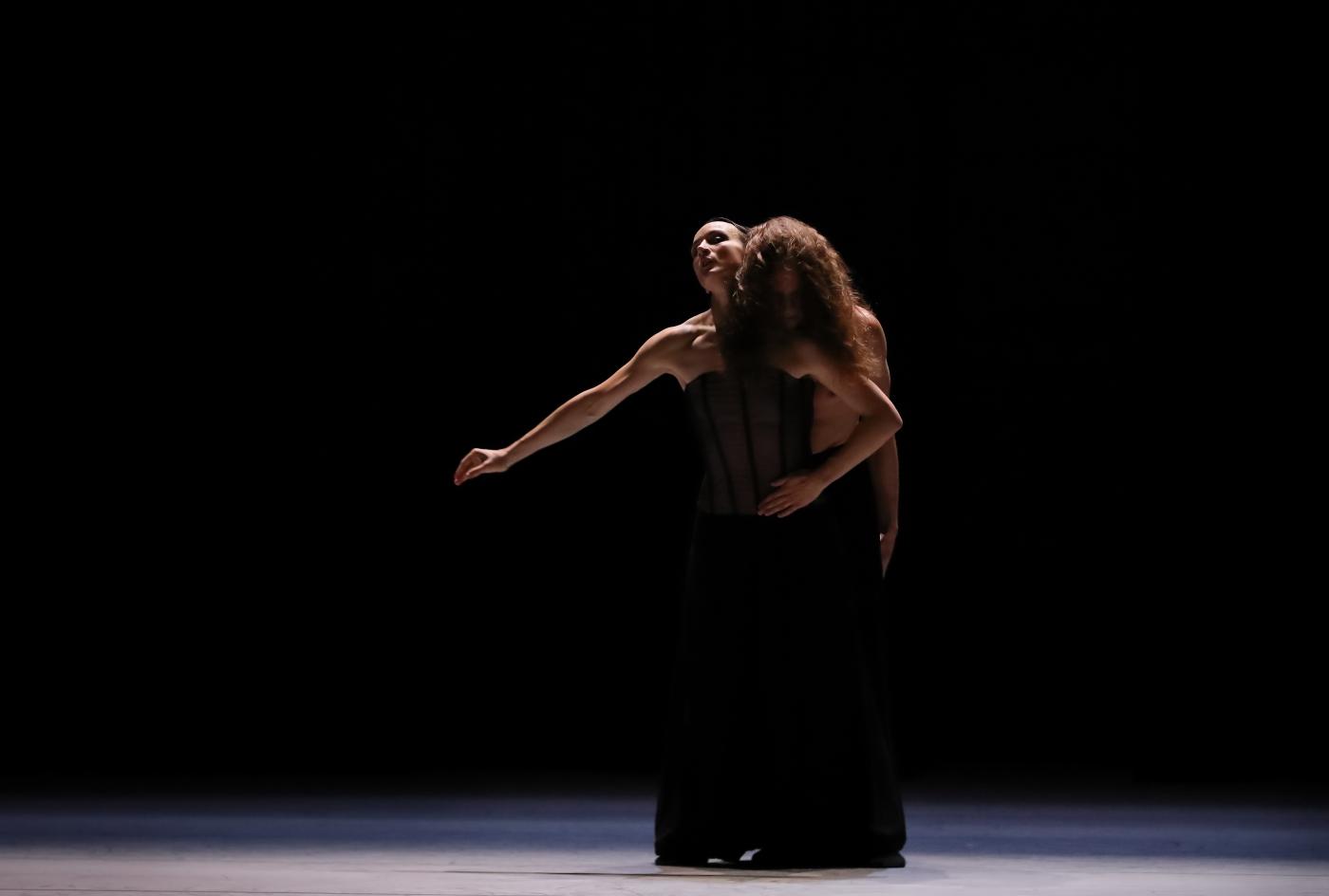
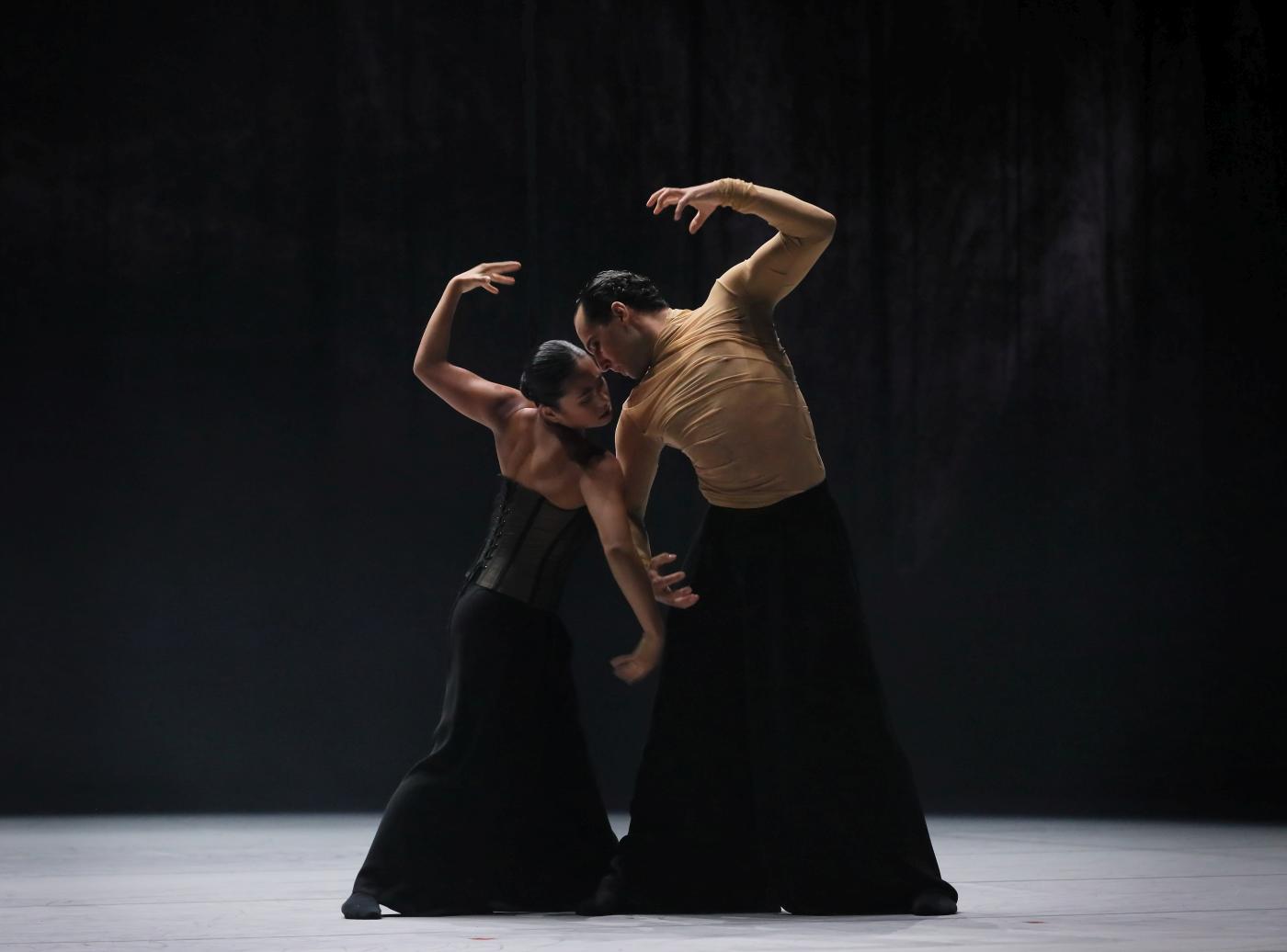 Solos and pas de deux alternated but lost steam halfway, as if Goecke had decoupled his choreography from the pressure the music had built up—or was meant to build up. The Orchestra of the State Theater am Gärtnerplatz, playing under the baton of Michael Brandstetter, screwed up their solos and lacked clarity and punch. Nevertheless, some scenes were memorable. A man in a black feathery top panted, his arms flailing as if fighting an invisible enemy. Of the few feathers he left behind, one was taken by a woman who gently blew it off her hand. Although I couldn’t understand the few French sentences some dancers hissed, I recognized some words: “Paris,” “David,” and “Bonsoir.”
Solos and pas de deux alternated but lost steam halfway, as if Goecke had decoupled his choreography from the pressure the music had built up—or was meant to build up. The Orchestra of the State Theater am Gärtnerplatz, playing under the baton of Michael Brandstetter, screwed up their solos and lacked clarity and punch. Nevertheless, some scenes were memorable. A man in a black feathery top panted, his arms flailing as if fighting an invisible enemy. Of the few feathers he left behind, one was taken by a woman who gently blew it off her hand. Although I couldn’t understand the few French sentences some dancers hissed, I recognized some words: “Paris,” “David,” and “Bonsoir.”
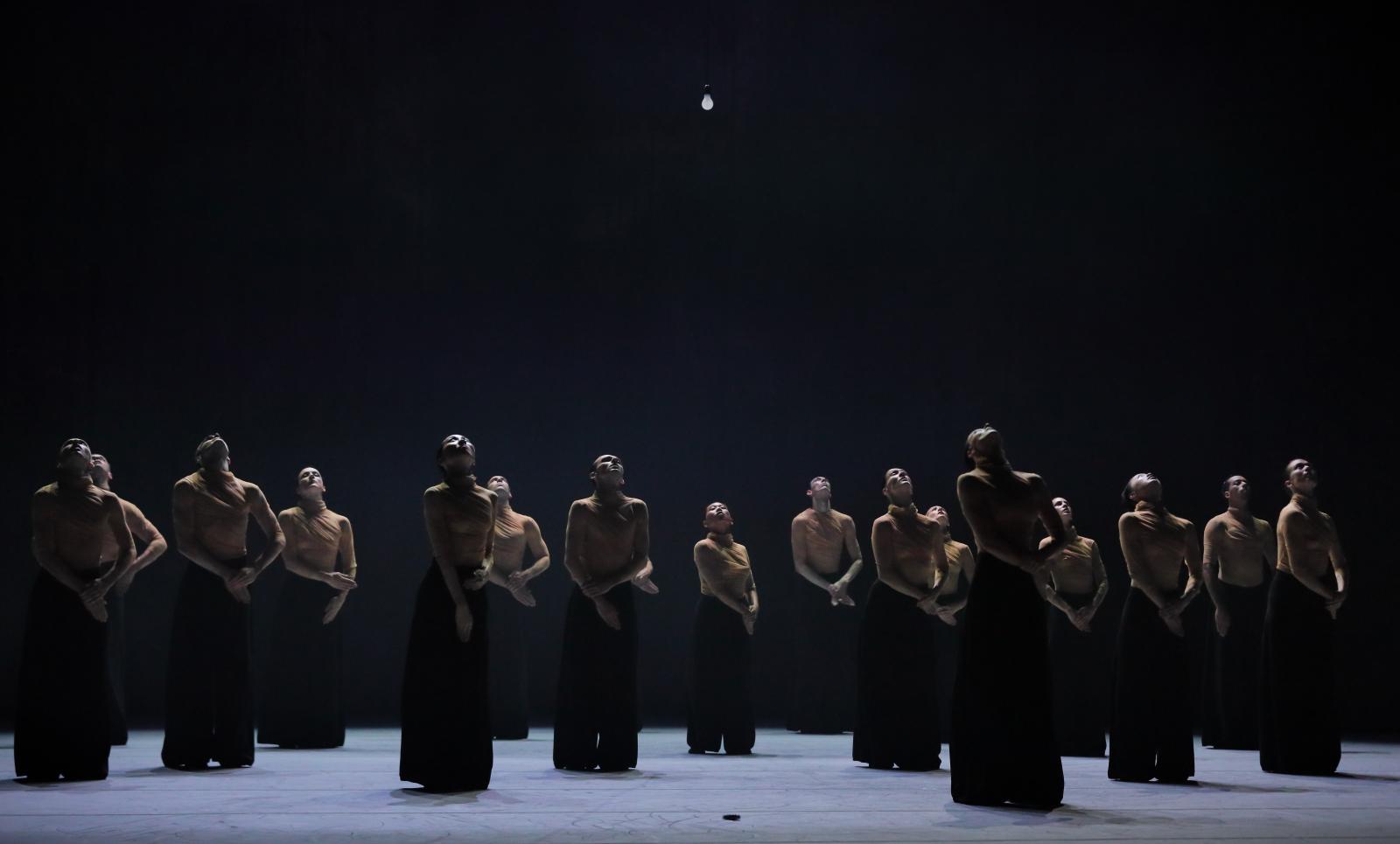
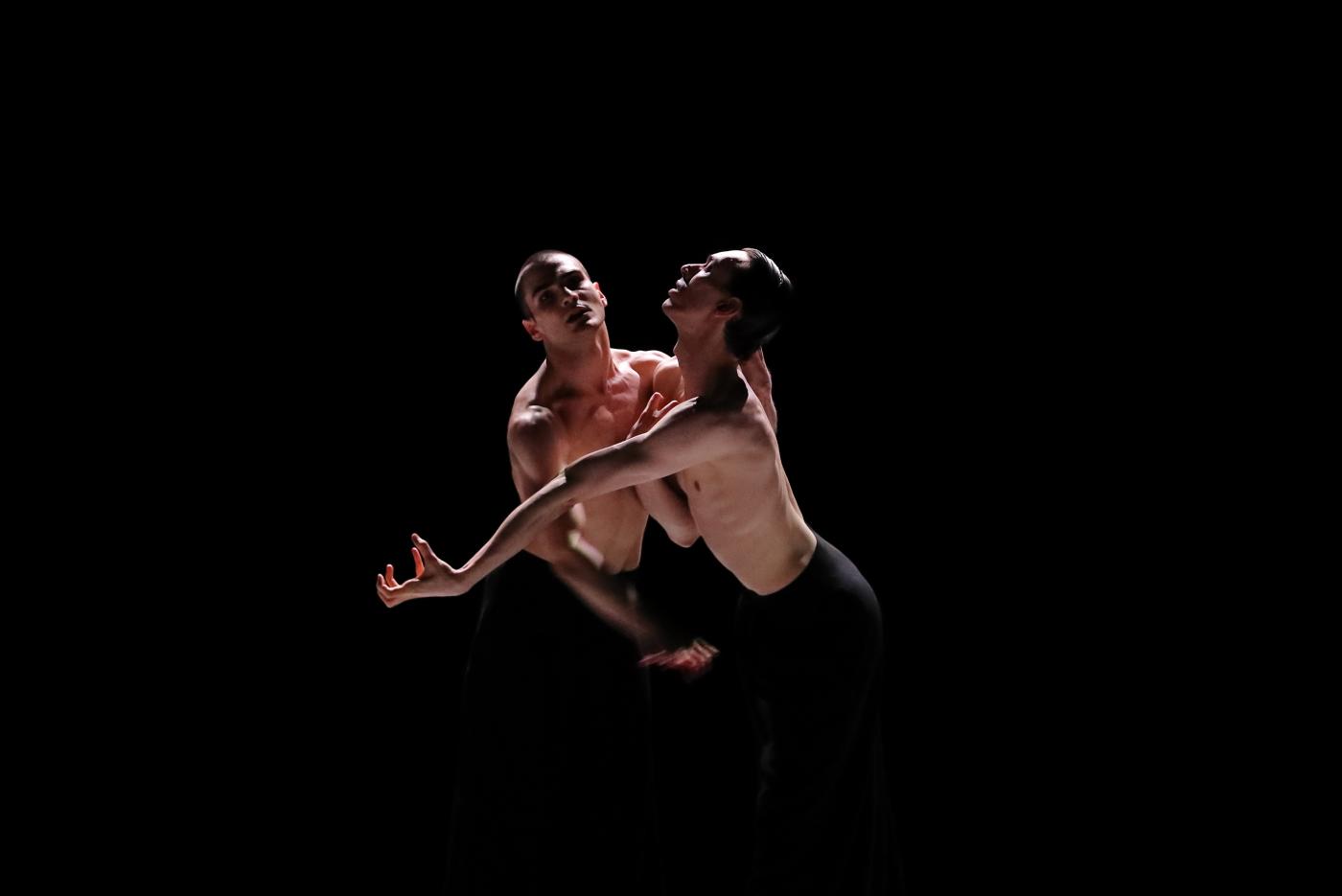 The naked light bulb that was lowered from above and suddenly switched on was an all-too-obvious pep-up prop. It flickered as the man in feathers reappeared. Maybe he was the Chosen One I was waiting for? Was the man in feathers the same as the one who ran off after the final solo, his head bald like a plucked chicken and his mouth paralyzed by a grotesque grin? In any case, the light bulb was switched off as if to put an exclamation mark at the end of the sacrifice.
The naked light bulb that was lowered from above and suddenly switched on was an all-too-obvious pep-up prop. It flickered as the man in feathers reappeared. Maybe he was the Chosen One I was waiting for? Was the man in feathers the same as the one who ran off after the final solo, his head bald like a plucked chicken and his mouth paralyzed by a grotesque grin? In any case, the light bulb was switched off as if to put an exclamation mark at the end of the sacrifice.
Interestingly, Goecke’s perspective on the piece wasn’t that of making a sacrifice but of being a sacrificial victim (and simultaneously a culprit). He generally felt himself a victim of everything into which he immersed himself, life included. Goecke also revealed that fear is both an engine and a demon of his creativity. The greater the fear, the greater the courage needed to overcome it. Goecke’s pieces have substance, but their continuous tension is sometimes exhausting. Verbruggen’s Farewell in Paris, by comparison, made me wonder if the Gärtnerplatztheater is aware of the cultural level it presented.
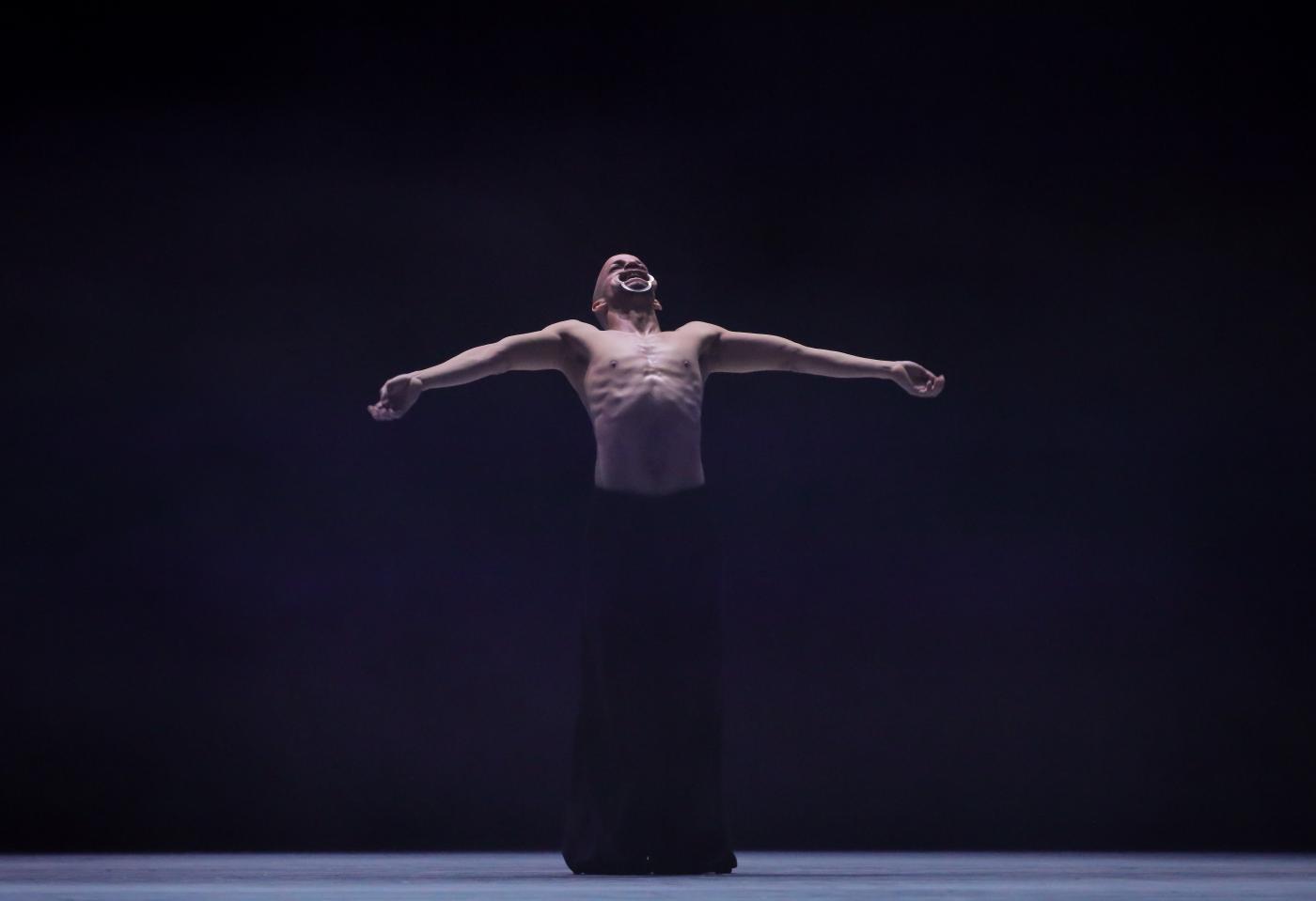
| Links: | Website of the Ludwigsburg Festival | |
| Website of the Forum Ludwigsburg | ||
| Website of the Gärtnerplatztheater | ||
| “Stravinsky in Paris”—Trailer | ||
| Jeroen Verbruggen on “Farewell in Paris” | ||
| Marco Goecke on “Le Sacre du Printemps” | ||
| Photos: | 1. | Matthew Jared Perko (Jerry) and ensemble, “Farewell in Paris” by Jeroen Verbruggen, State Ballet of the Gärtnerplatztheater 2025 |
| 2. | Emily Yetta Wohl, Alexander Quetell, and ensemble; “Farewell in Paris” by Jeroen Verbruggen, State Ballet of the Gärtnerplatztheater 2025 | |
| 3. | Micaela Romano Serrano (Anima) and Ethan Ribeiro (Anima), “Farewell in Paris” by Jeroen Verbruggen, State Ballet of the Gärtnerplatztheater 2025 |
|
| 4. | Ethan Ribeiro (Anima) and Micaela Romano Serrano (Anima), “Farewell in Paris” by Jeroen Verbruggen, State Ballet of the Gärtnerplatztheater 2025 | |
| 5. | Matthew Jared Perko (Jerry) and ensemble, “Farewell in Paris” by Jeroen Verbruggen, State Ballet of the Gärtnerplatztheater 2025 | |
| 6. | Ensemble, “Farewell in Paris” by Jeroen Verbruggen, State Ballet of the Gärtnerplatztheater 2025 | |
| 7. | Ethan Ribeiro (Anima), Matthew Jared Perko (Jerry), and Micaela Romano Serrano (Anima); “Farewell in Paris” by Jeroen Verbruggen, State Ballet of the Gärtnerplatztheater 2025 | |
| 8. | Ethan Ribeiro (Anima), Matthew Jared Perko (Jerry), and Micaela Romano Serrano (Anima); “Farewell in Paris” by Jeroen Verbruggen, State Ballet of the Gärtnerplatztheater 2025 | |
| 9. | Micaela Romano Serrano (Anima), Matthew Jared Perko (Jerry), and Ethan Ribeiro (Anima); “Farewell in Paris” by Jeroen Verbruggen, State Ballet of the Gärtnerplatztheater 2025 | |
| 10. | Ethan Ribeiro and ensemble, “Le Sacre du Printemps” by Marco Goecke, State Ballet of the Gärtnerplatztheater 2025 | |
| 11. | Montana Dalton, Ethan Ribeiro, Micaela Romano Serrano, and ensemble; “Le Sacre du Printemps” by Marco Goecke, State Ballet of the Gärtnerplatztheater 2025 | |
| 12. | Joel Distefano and ensemble, “Le Sacre du Printemps” by Marco Goecke, State Ballet of the Gärtnerplatztheater 2025 | |
| 13. | Ensemble, “Le Sacre du Printemps” by Marco Goecke, State Ballet of the Gärtnerplatztheater 2025 | |
| 14. | Jana Baldovino and Joel Distefano, “Le Sacre du Printemps” by Marco Goecke, State Ballet of the Gärtnerplatztheater 2025 | |
| 15. | Ariane Roustan and Alexander Quetell, “Le Sacre du Printemps” by Marco Goecke, State Ballet of the Gärtnerplatztheater 2025 | |
| 16. | Ensemble, “Le Sacre du Printemps” by Marco Goecke, State Ballet of the Gärtnerplatztheater 2025 | |
| 17. | Francesco Cuoccio and Gjergji Meshaj, “Le Sacre du Printemps” by Marco Goecke, State Ballet of the Gärtnerplatztheater 2025 | |
| 18. | David Valencia, “Le Sacre du Printemps” by Marco Goecke, State Ballet of the Gärtnerplatztheater 2025 | |
| all photos © Marie-Laure Briane | ||
| Editing: | Kayla Kauffman |
